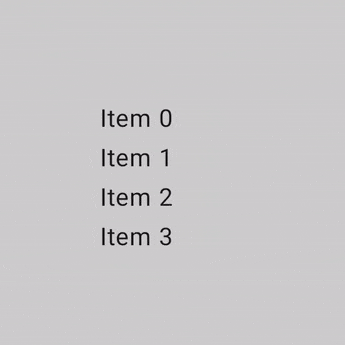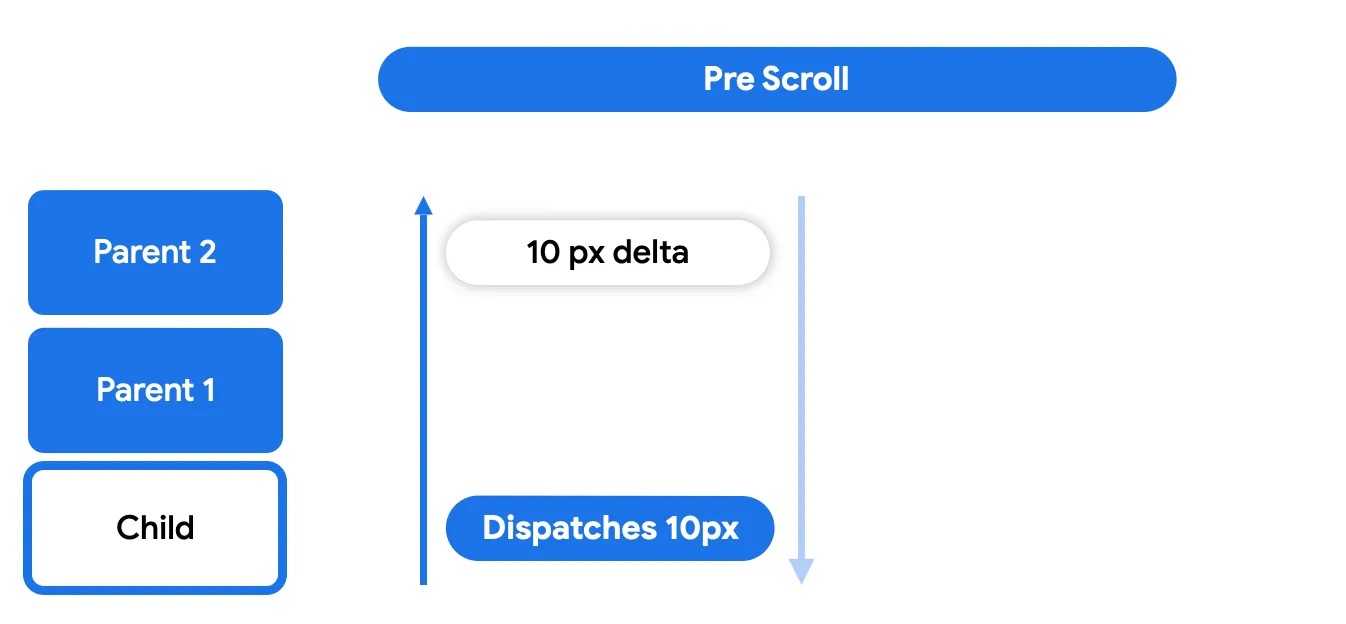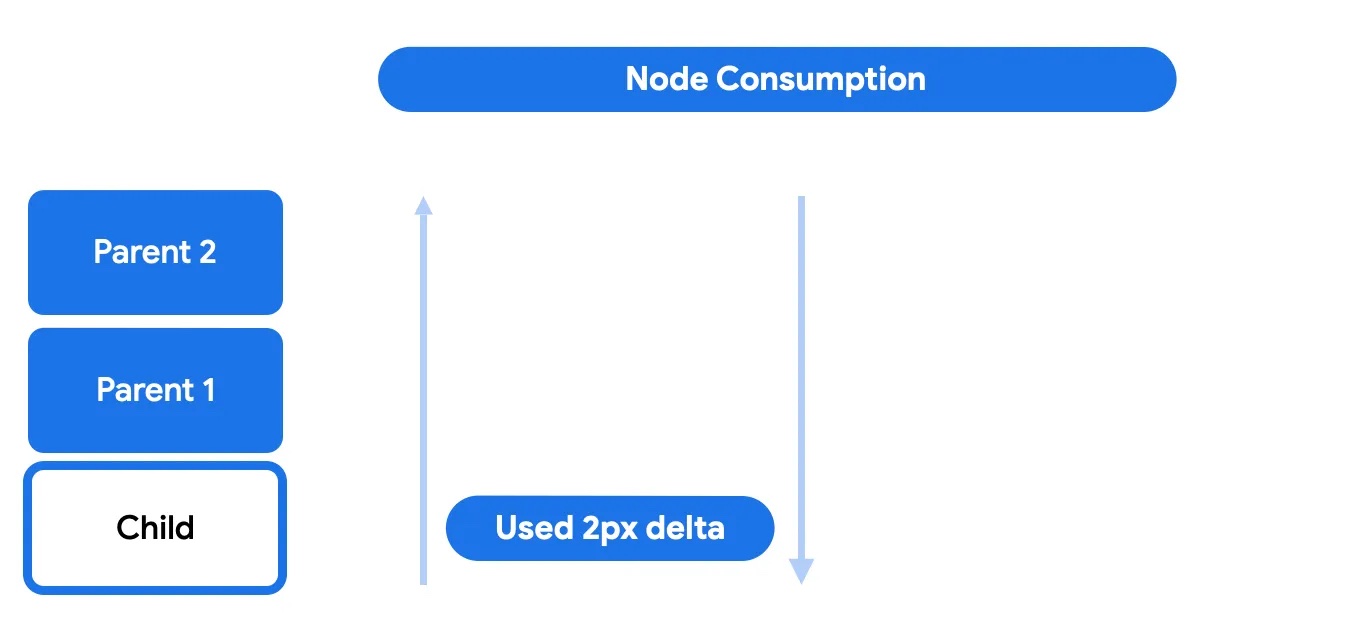捲動修飾符
在元素的內容邊界超過尺寸上限時,使用 verticalScroll 和 horizontalScroll 修飾符可以讓使用者以最簡單的方式捲動元素。只要使用 verticalScroll 和 horizontalScroll 修飾符,就不必平移或偏移內容。
@Composable private fun ScrollBoxes() { Column( modifier = Modifier .background(Color.LightGray) .size(100.dp) .verticalScroll(rememberScrollState()) ) { repeat(10) { Text("Item $it", modifier = Modifier.padding(2.dp)) } } }

ScrollState 可讓您變更捲動位置或取得其目前狀態。如要使用預設參數建立,請使用 rememberScrollState()。
@Composable private fun ScrollBoxesSmooth() { // Smoothly scroll 100px on first composition val state = rememberScrollState() LaunchedEffect(Unit) { state.animateScrollTo(100) } Column( modifier = Modifier .background(Color.LightGray) .size(100.dp) .padding(horizontal = 8.dp) .verticalScroll(state) ) { repeat(10) { Text("Item $it", modifier = Modifier.padding(2.dp)) } } }
scrollable 修飾符
scrollable 修飾符和 scroll 修飾符不同,scrollable 會偵測捲動手勢並擷取增量,但不會自動位移內容。而是透過 ScrollableState 委派給使用者,這個修飾符需要這項權限才能正常運作。
建構 ScrollableState 時,您必須提供 consumeScrollDelta 函式,利用手勢輸入、流暢捲動或快速滑過執行每個捲動步驟時,系統都會叫用該函式,並以像素呈現差異。此函式必須傳回使用的捲動距離量,以確保事件在含有 scrollable 修飾符的巢狀元素時能正確傳播。
下列程式碼片段會偵測手勢並顯示位移數值,但不會使任何元素位移:
@Composable private fun ScrollableSample() { // actual composable state var offset by remember { mutableFloatStateOf(0f) } Box( Modifier .size(150.dp) .scrollable( orientation = Orientation.Vertical, // Scrollable state: describes how to consume // scrolling delta and update offset state = rememberScrollableState { delta -> offset += delta delta } ) .background(Color.LightGray), contentAlignment = Alignment.Center ) { Text(offset.toString()) } }

巢狀捲動
巢狀捲動是指多個捲動元件彼此包含,並透過回應單一捲動手勢及傳達捲動增量 (變更) 共同運作的系統。
巢狀捲動系統可協調可捲動且階層式連結的元件 (通常是共用同一個父項)。這個系統會連結捲動容器,並允許與在兩者之間傳播及共用的捲動增量互動。
Compose 提供多種方法,可處理可組合項之間的巢狀捲動。在清單中包含另一個清單,是典型的巢狀捲動運用,而較複雜的用途則是收合工具列。
自動巢狀捲動
簡易的巢狀捲動功能無需使用者執行任何動作。觸發捲動動作的手勢會自動從子項套用到父項,因此,當子項無法再捲動畫面時,就會由父項元素處理該手勢。
自動巢狀捲動功能是由部分 Compose 元件和修飾符直接支援並提供,包括:verticalScroll、horizontalScroll、scrollable、Lazy API 與 TextField。這表示當使用者捲動巢狀元件的內部子項時,先前的修飾符會將捲動差異傳播至支援巢狀捲動功能的父項。
以下範例顯示已套用 verticalScroll 修飾符的元素,位於同樣套用 verticalScroll 修飾符的容器中。
@Composable private fun AutomaticNestedScroll() { val gradient = Brush.verticalGradient(0f to Color.Gray, 1000f to Color.White) Box( modifier = Modifier .background(Color.LightGray) .verticalScroll(rememberScrollState()) .padding(32.dp) ) { Column { repeat(6) { Box( modifier = Modifier .height(128.dp) .verticalScroll(rememberScrollState()) ) { Text( "Scroll here", modifier = Modifier .border(12.dp, Color.DarkGray) .background(brush = gradient) .padding(24.dp) .height(150.dp) ) } } } } }

使用 nestedScroll 修飾符
如果您需要在多個元素間建立進階協調捲動功能,nestedScroll 修飾符可定義巢狀捲動階層,讓您擁有更多彈性。如前所述,部分元件已內建支援巢狀捲動。不過,像是 Box 或 Column 這類無法自動捲動的可組合元件,便無法在巢狀捲動系統中傳播捲動差異,且差異也無法進入 NestedScrollConnection 或父項元件。如要解決這個問題,您可以使用 nestedScroll 將這類支援權限授予其他元件,包括自訂元件。
巢狀捲動週期
巢狀捲動週期是指捲動增量在階層樹狀結構中上下傳送的流程,會經過巢狀捲動系統中的所有元件 (或節點),例如使用可捲動的元件和修飾符,或 nestedScroll。
巢狀捲動週期的階段
當可捲動元件偵測到觸發事件 (例如手勢) 時,在實際觸發捲動動作之前,產生的增量會傳送至巢狀捲動系統,並經歷三個階段:捲動前、節點耗用和捲動後。

在第一個捲動前階段,收到觸發事件增量的元件會透過階層樹狀結構,將這些事件向上分派至最上層的父項。接著,增量事件會向下傳播,也就是說,增量會從最上層的父項向下傳播至啟動巢狀捲動週期的子項。

這樣一來,巢狀捲動父項 (使用 nestedScroll 或可捲動修飾符的可組合函式) 就能在節點本身使用差異前,先對差異執行某些操作。

在節點耗用階段,節點本身會使用父項未使用的任何差異。這是實際完成捲動動作並顯示捲動內容的時間。

在這段期間,孩子可以選擇使用剩餘的捲軸,剩餘的項目會送回,以完成捲動後階段。
最後,在捲動後階段,節點本身未消耗的任何內容都會再次傳送至上層元素以供消耗。

捲動後階段的運作方式與捲動前階段類似,任何父項都可以選擇是否要取用。

與捲動類似,當拖曳手勢完成時,使用者的意圖可能會轉換為速度,用於甩動 (使用動畫捲動) 可捲動的容器。Fling 也屬於巢狀捲動週期,且拖曳事件產生的速度會經歷類似的階段:前置 Fling、節點耗用和後置 Fling。請注意,甩動動畫只會與觸控手勢相關聯,不會由其他事件觸發,例如無障礙或硬體捲動。
參與巢狀捲動週期
參與週期表示要攔截、消耗及回報階層中增量的消耗量。Compose 提供一系列工具,可影響巢狀捲動系統的運作方式,以及如何直接與該系統互動,例如您需要在可捲動的元件開始捲動前,對捲動增量執行某些操作。
如果巢狀捲動週期是系統對節點鏈結執行的動作,則 nestedScroll 修飾符可攔截並插入這些變更,以及影響鏈結中傳播的資料 (捲動增量)。這個修飾符可以放在階層中的任何位置,並與樹狀結構中巢狀捲動修飾符例項通訊,因此可以透過這個管道分享資訊。這個修飾符的建構區塊為 NestedScrollConnection 和 NestedScrollDispatcher。
NestedScrollConnection 提供方法,可回應巢狀捲動週期的階段,並影響巢狀捲動系統。這四個回呼方法分別代表一個消耗階段:捲動前/後和快速滑動前/後:
val nestedScrollConnection = object : NestedScrollConnection { override fun onPreScroll(available: Offset, source: NestedScrollSource): Offset { println("Received onPreScroll callback.") return Offset.Zero } override fun onPostScroll( consumed: Offset, available: Offset, source: NestedScrollSource ): Offset { println("Received onPostScroll callback.") return Offset.Zero } }
每個回呼也會提供所傳播差異的相關資訊:特定階段的 available 差異,以及前幾個階段中使用的 consumed 差異。如果之後想停止在階層中向上傳播差異,可以使用巢狀捲動連線:
val disabledNestedScrollConnection = remember { object : NestedScrollConnection { override fun onPostScroll( consumed: Offset, available: Offset, source: NestedScrollSource ): Offset { return if (source == NestedScrollSource.SideEffect) { available } else { Offset.Zero } } } }
所有回呼都會提供NestedScrollSource型別的資訊。
NestedScrollDispatcher
初始化巢狀捲動週期。使用調度器並呼叫其方法會觸發週期。可捲動的容器內建的調度器會將手勢期間擷取的增量傳送至系統。因此,在大多數自訂巢狀捲動的使用情況中,都會使用 NestedScrollConnection 而不是分派器,以便對現有的差異做出反應,而不是傳送新的差異。如需更多用法,請參閱 NestedScrollDispatcherSample。
在捲動時調整圖片大小
使用者捲動畫面時,您可以建立動態視覺效果,讓圖片根據捲動位置改變大小。
根據捲動位置調整圖片大小
這個程式碼片段示範如何根據垂直捲動位置,在 LazyColumn 內調整圖片大小。圖片會隨著使用者向下捲動而縮小,向上捲動時則會放大,但仍會維持在定義的最小和最大尺寸界線內:
@Composable fun ImageResizeOnScrollExample( modifier: Modifier = Modifier, maxImageSize: Dp = 300.dp, minImageSize: Dp = 100.dp ) { var currentImageSize by remember { mutableStateOf(maxImageSize) } var imageScale by remember { mutableFloatStateOf(1f) } val nestedScrollConnection = remember { object : NestedScrollConnection { override fun onPreScroll(available: Offset, source: NestedScrollSource): Offset { // Calculate the change in image size based on scroll delta val delta = available.y val newImageSize = currentImageSize + delta.dp val previousImageSize = currentImageSize // Constrain the image size within the allowed bounds currentImageSize = newImageSize.coerceIn(minImageSize, maxImageSize) val consumed = currentImageSize - previousImageSize // Calculate the scale for the image imageScale = currentImageSize / maxImageSize // Return the consumed scroll amount return Offset(0f, consumed.value) } } } Box(Modifier.nestedScroll(nestedScrollConnection)) { LazyColumn( Modifier .fillMaxWidth() .padding(15.dp) .offset { IntOffset(0, currentImageSize.roundToPx()) } ) { // Placeholder list items items(100, key = { it }) { Text( text = "Item: $it", style = MaterialTheme.typography.bodyLarge ) } } Image( painter = ColorPainter(Color.Red), contentDescription = "Red color image", Modifier .size(maxImageSize) .align(Alignment.TopCenter) .graphicsLayer { scaleX = imageScale scaleY = imageScale // Center the image vertically as it scales translationY = -(maxImageSize.toPx() - currentImageSize.toPx()) / 2f } ) } }
程式碼重點
- 這個程式碼會使用
NestedScrollConnection攔截捲動事件。 onPreScroll會根據捲動增量計算圖片大小的變化。currentImageSize狀態變數會儲存圖片的目前大小,並限制在minImageSize和maxImageSize. imageScale之間,而currentImageSize則會衍生自currentImageSize。LazyColumn會根據currentImageSize偏移。Image會使用graphicsLayer修飾符套用計算出的比例。translationY內的graphicsLayer可確保圖片在縮放時保持垂直置中。
結果
上述程式碼片段會產生圖片在捲動時縮放的效果:
巢狀捲動互通性
如果想在捲動式可組合函式中建立巢狀捲動 View 元素 (或相反情況),可能會發生問題。最容易判別的情況,就是當將子項捲動到開頭或尾端時,本應由父項接續捲動,但是並未發生預期的行為,或是實際運作方式和預期內容不同。
這可能是由於捲動式可組合元件內建的預期情況所導致的。捲動式可組合元件具有「預設建立巢狀捲動」的規則,因此任何可以捲動的容器都必須加入巢狀捲動鏈結,包括透過 NestedScrollConnection 方式作為父項,以及透過 NestedScrollDispatcher 方式作為子項。當子項抵達邊界時,就會對父項驅動巢狀捲動。舉例來說,這項規則可以讓您同時正常使用 Compose Pager 和 Compose LazyRow。不過,如果使用 ViewPager2 或 RecyclerView 達成互通性捲動,則由於這些元件並未實作 NestedScrollingParent3,因此子項無法將捲動延續到父項。
如果想啟用可在捲動式 View 與捲動式可組合元件之間同時使用的巢狀捲動互通性 API,讓兩個方向皆使用巢狀結構,那麼在以下情況中,您可以使用巢狀捲動互通性 API 緩解這類問題。
含有子項 ComposeView 的合作執行父項 View
合作執行父項 View 已經實作 NestedScrollingParent3,因此可以從合作執行的巢狀子項可組合元件接收捲動差異。在這種情況下,ComposeView 會作為子項,並需用間接方式實作 NestedScrollingChild3。合作執行父項的範例之一就是 androidx.coordinatorlayout.widget.CoordinatorLayout。
如需在捲動式 View 父項容器和巢狀捲動式子項可組合元件之間建立巢狀捲動互通性,可使用 rememberNestedScrollInteropConnection()。
rememberNestedScrollInteropConnection() 可允許並記憶在實作 NestedScrollingParent3 的 View 父項和 Compose 子項之間啟用巢狀捲動互通性的 NestedScrollConnection。此內容應和 nestedScroll 修飾符一同使用。由於 Compose 端會預設啟用巢狀捲動,因此您可以利用這個連結,在 View 端啟用巢狀捲動,同時在 Views 和可組合函式之間新增必要的緊連邏輯。
常見的作法是使用 CoordinatorLayout、CollapsingToolbarLayout 和一個子項可組合函式,請看範例:
<androidx.coordinatorlayout.widget.CoordinatorLayout xmlns:android="http://schemas.android.com/apk/res/android" xmlns:app="http://schemas.android.com/apk/res-auto" android:layout_width="match_parent" android:layout_height="match_parent"> <com.google.android.material.appbar.AppBarLayout android:id="@+id/app_bar" android:layout_width="match_parent" android:layout_height="100dp" android:fitsSystemWindows="true"> <com.google.android.material.appbar.CollapsingToolbarLayout android:id="@+id/collapsing_toolbar_layout" android:layout_width="match_parent" android:layout_height="match_parent" android:fitsSystemWindows="true" app:layout_scrollFlags="scroll|exitUntilCollapsed"> <!--...--> </com.google.android.material.appbar.CollapsingToolbarLayout> </com.google.android.material.appbar.AppBarLayout> <androidx.compose.ui.platform.ComposeView android:id="@+id/compose_view" app:layout_behavior="@string/appbar_scrolling_view_behavior" android:layout_width="match_parent" android:layout_height="match_parent"/> </androidx.coordinatorlayout.widget.CoordinatorLayout>
您需要在「Activity」(活動) 或「Fragment」(片段) 中設定子項可組合元件,以及必要的 NestedScrollConnection:
open class MainActivity : ComponentActivity() { override fun onCreate(savedInstanceState: Bundle?) { super.onCreate(savedInstanceState) setContentView(R.layout.activity_main) findViewById<ComposeView>(R.id.compose_view).apply { setContent { val nestedScrollInterop = rememberNestedScrollInteropConnection() // Add the nested scroll connection to your top level @Composable element // using the nestedScroll modifier. LazyColumn(modifier = Modifier.nestedScroll(nestedScrollInterop)) { items(20) { item -> Box( modifier = Modifier .padding(16.dp) .height(56.dp) .fillMaxWidth() .background(Color.Gray), contentAlignment = Alignment.Center ) { Text(item.toString()) } } } } } } }
含有子項 AndroidView 的父項可組合函式
在這個案例中,當您有父項內含子項 AndroidView 時,可藉此在 Compose 端實作巢狀捲動互通性 API。AndroidView 是 Compose 捲動父項的子項,因此會實作 NestedScrollDispatcher;同時,由於它也是 View 捲動子項的父項,因此會實作 NestedScrollingParent3。接下來,Compose 父項便可以從巢狀捲動子項 View 接收巢狀捲動的差異。
以下範例說明如何在這種情況和 Compose 收合工具列的條件下達成巢狀捲動互通性:
@Composable
private fun NestedScrollInteropComposeParentWithAndroidChildExample() {
val toolbarHeightPx = with(LocalDensity.current) { ToolbarHeight.roundToPx().toFloat() }
val toolbarOffsetHeightPx = remember { mutableStateOf(0f) }
// Sets up the nested scroll connection between the Box composable parent
// and the child AndroidView containing the RecyclerView
val nestedScrollConnection = remember {
object : NestedScrollConnection {
override fun onPreScroll(available: Offset, source: NestedScrollSource): Offset {
// Updates the toolbar offset based on the scroll to enable
// collapsible behaviour
val delta = available.y
val newOffset = toolbarOffsetHeightPx.value + delta
toolbarOffsetHeightPx.value = newOffset.coerceIn(-toolbarHeightPx, 0f)
return Offset.Zero
}
}
}
Box(
Modifier
.fillMaxSize()
.nestedScroll(nestedScrollConnection)
) {
TopAppBar(
modifier = Modifier
.height(ToolbarHeight)
.offset { IntOffset(x = 0, y = toolbarOffsetHeightPx.value.roundToInt()) }
)
AndroidView(
{ context ->
LayoutInflater.from(context)
.inflate(R.layout.view_in_compose_nested_scroll_interop, null).apply {
with(findViewById<RecyclerView>(R.id.main_list)) {
layoutManager = LinearLayoutManager(context, VERTICAL, false)
adapter = NestedScrollInteropAdapter()
}
}.also {
// Nested scrolling interop is enabled when
// nested scroll is enabled for the root View
ViewCompat.setNestedScrollingEnabled(it, true)
}
},
// ...
)
}
}
private class NestedScrollInteropAdapter :
Adapter<NestedScrollInteropAdapter.NestedScrollInteropViewHolder>() {
val items = (1..10).map { it.toString() }
override fun onCreateViewHolder(
parent: ViewGroup,
viewType: Int
): NestedScrollInteropViewHolder {
return NestedScrollInteropViewHolder(
LayoutInflater.from(parent.context)
.inflate(R.layout.list_item, parent, false)
)
}
override fun onBindViewHolder(holder: NestedScrollInteropViewHolder, position: Int) {
// ...
}
class NestedScrollInteropViewHolder(view: View) : ViewHolder(view) {
fun bind(item: String) {
// ...
}
}
// ...
}
本範例可以說明如何透過 scrollable 修飾符使用 API:
@Composable
fun ViewInComposeNestedScrollInteropExample() {
Box(
Modifier
.fillMaxSize()
.scrollable(rememberScrollableState {
// View component deltas should be reflected in Compose
// components that participate in nested scrolling
it
}, Orientation.Vertical)
) {
AndroidView(
{ context ->
LayoutInflater.from(context)
.inflate(android.R.layout.list_item, null)
.apply {
// Nested scrolling interop is enabled when
// nested scroll is enabled for the root View
ViewCompat.setNestedScrollingEnabled(this, true)
}
}
)
}
}
最後,這個範例可以說明如何透過 BottomSheetDialogFragment 使用巢狀捲動互通性 API,藉此成功達成拖曳和關閉行為:
class BottomSheetFragment : BottomSheetDialogFragment() {
override fun onCreateView(
inflater: LayoutInflater,
container: ViewGroup?,
savedInstanceState: Bundle?
): View {
val rootView: View = inflater.inflate(R.layout.fragment_bottom_sheet, container, false)
rootView.findViewById<ComposeView>(R.id.compose_view).apply {
setContent {
val nestedScrollInterop = rememberNestedScrollInteropConnection()
LazyColumn(
Modifier
.nestedScroll(nestedScrollInterop)
.fillMaxSize()
) {
item {
Text(text = "Bottom sheet title")
}
items(10) {
Text(
text = "List item number $it",
modifier = Modifier.fillMaxWidth()
)
}
}
}
return rootView
}
}
}
請注意,rememberNestedScrollInteropConnection() 會在您附加的元素中安裝 NestedScrollConnection。NestedScrollConnection 負責從 Compose 層級傳送差異到 View 層級。這樣做即可讓元素加入巢狀捲動,但是無法自動捲動元素。像是 Box 或 Column 這類無法自動捲動的可組合函式,便無法在巢狀捲動系統中傳播捲動差異,且差異無法進入 rememberNestedScrollInteropConnection() 提供的 NestedScrollConnection,因此,差異無法進入父項 View 元件。如要解決這個問題,請務必同時將捲動修飾符設定為這些巢狀可組合元件的類型。如需更多詳細資訊,請參閱上述的巢狀捲動一節。
含有子項 ComposeView 的非合作執行父項 View
非合作執行的 View 並未在 View 端實作必要的 NestedScrolling 介面。請注意,這代表具有 Views 的巢狀捲動互通性無法供您馬上使用。非合作執行的 Views 為 RecyclerView 和 ViewPager2。
其他資源
為您推薦
- 注意:系統會在 JavaScript 關閉時顯示連結文字
- 瞭解手勢
- 將
CoordinatorLayout遷移至 Compose - 在 Compose 中使用 View

